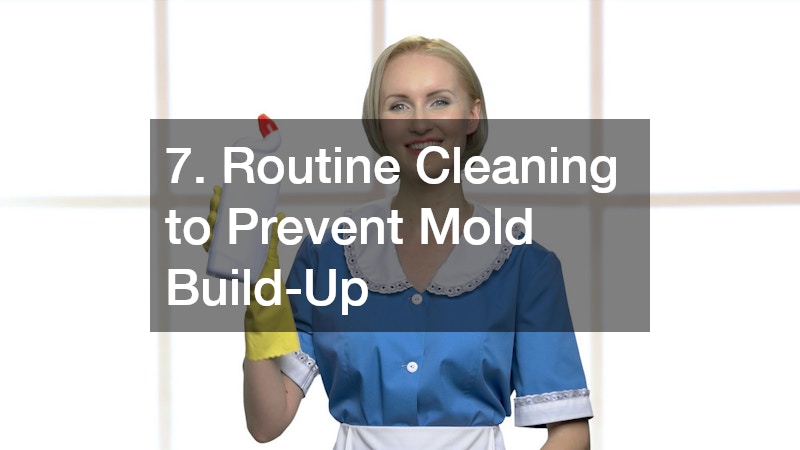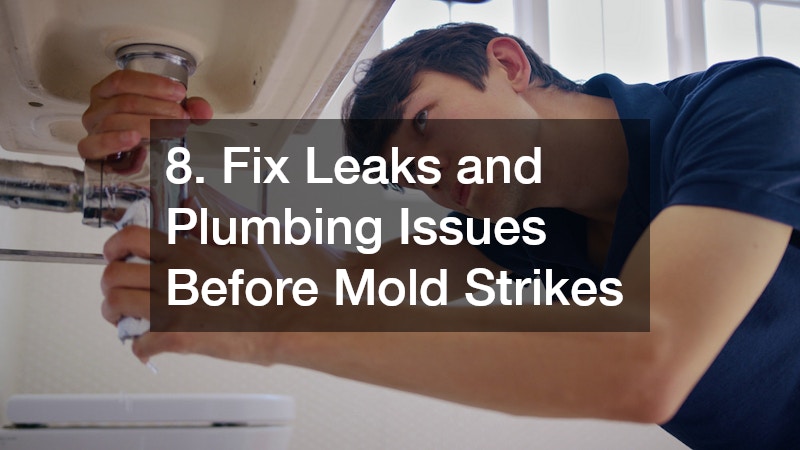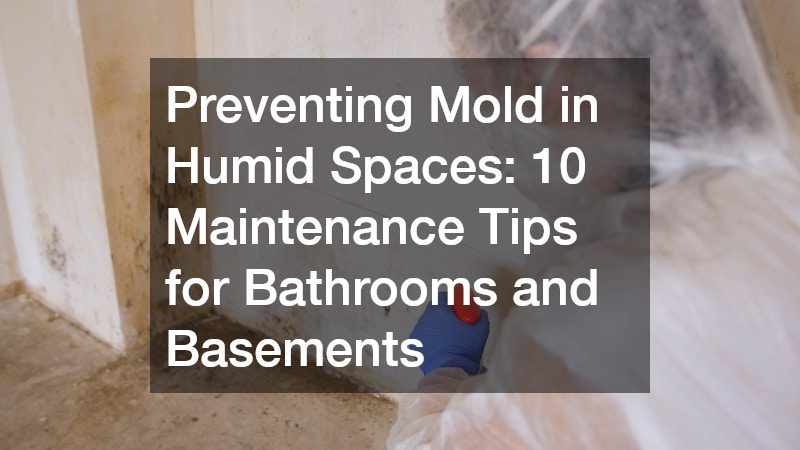Mold is one of those problems that can creep up quietly in your home, especially in places that are naturally damp like bathrooms and basements. It doesn’t just look unpleasant—it can damage your property and even affect your health. The good news is that with a little awareness and some practical steps, you can prevent mold from becoming a serious issue.
In this guide, we’ll walk through why mold thrives in these areas, the signs to watch for, and the practical maintenance steps you can take to keep your home dry and mold-free. From ventilation and dehumidifiers to waterproofing and material choices, these tips cover everything you need to know to stay ahead of mold growth.
1. Know Why Bathrooms and Basements Are at Risk

Bathrooms and basements are naturally vulnerable to moisture, which makes them prime targets for mold growth. In bathrooms, steam from showers and baths can linger on walls, ceilings, and grout, creating a moist environment where mold spores can thrive. Basements, often below ground level, tend to retain humidity from soil moisture, minor leaks, or condensation on cold surfaces. Even small plumbing issues, like slow leaks or dripping pipes, can create pockets of dampness that accelerate mold growth if not addressed promptly.
Mold can grow silently, feeding on materials like wood, drywall, and even wallpaper. It can weaken structures over time and produce allergens or irritants that affect your family’s health. Routine maintenance, such as timely plumbing repairs, is critical to prevent hidden moisture from fueling mold growth. Understanding why these areas are susceptible is the first step in implementing effective prevention strategies and keeping your home safe.
2. Watch Out for These Common Signs of Mold Growth
Mold doesn’t always make itself obvious. Sometimes it starts small and goes unnoticed until it spreads, making early detection crucial. Here are some common warning signs:
-
Musty odors: A persistent, earthy smell is often the first indication of hidden mold.
-
Discoloration: Look for black, green, or white patches on walls, ceilings, or grout.
-
Peeling or bubbling paint: Moisture trapped behind paint can cause it to lift or bubble.
-
Health symptoms: Unexplained coughing, sneezing, or irritation, especially in certain areas of your home.
Paying attention to these signs allows you to take action before the mold becomes widespread. Catching mold early not only protects your health and home but also makes professional mold removal easier, faster, and less costly. Regular inspections and prompt intervention are key to staying ahead of potential infestations.
3. Understand the Role of Humidity in Mold Development
Humidity is a major factor in mold growth. Mold spores need moisture to thrive, and even small increases in humidity can create an environment where spores multiply quickly. Bathrooms often experience high humidity during and after showers, while basements can maintain damp conditions from groundwater, condensation, or inadequate ventilation. Managing these moisture levels early can prevent more serious problems, and when issues do occur, water damage repair helps restore affected areas efficiently.
Managing indoor humidity is key to preventing mold. Keeping moisture levels low not only makes your home healthier but also helps maintain building materials. Using tools and strategies to control humidity—like proper ventilation, dehumidifiers, and moisture barriers—can make a significant difference in reducing the risk of mold.
4. Maintain Proper Ventilation

Good ventilation is one of the simplest and most effective ways to reduce moisture and prevent mold. Bathrooms benefit greatly from exhaust fans that remove humid air directly outside. Running fans during and after showers or baths helps prevent moisture from lingering on surfaces, including walls, ceilings, and grout lines. Opening a window when possible can also help, especially in smaller bathrooms where humidity builds quickly.
Basements may require additional ventilation to promote airflow, particularly in areas that tend to feel damp or musty. Consider installing vents, windows, or mechanical ventilation systems to keep air circulating. Using fans or dehumidifiers in conjunction with ventilation can further speed up drying in problem areas. Proper airflow not only dries damp areas more quickly but also helps prevent condensation on surfaces like pipes, walls, and floors, making it much harder for mold to take hold. Regularly checking and maintaining these ventilation systems ensures they continue working efficiently over time.
5. Use Dehumidifiers Effectively in Damp Spaces
Dehumidifiers are a great tool for controlling indoor humidity, especially in basements or bathrooms that don’t get enough natural airflow. A properly sized dehumidifier can remove excess moisture from the air, lowering humidity levels to a range that is less hospitable for mold. Using a dehumidifier consistently can make a noticeable difference in the overall comfort of your home and help protect walls, floors, and furniture from moisture damage.
Here are some tips for using dehumidifiers effectively:
-
Place the unit strategically: Position the dehumidifier in the center of the dampest area or near moisture sources for optimal performance.
-
Regular maintenance: Clean and maintain the filter to ensure the unit runs efficiently and continues to remove moisture effectively.
-
Monitor humidity levels: Keep an eye on readings and adjust settings as needed to maintain a consistent, safe humidity level (usually between 30–50%).
-
Manage water collection: Empty the water reservoir frequently, or connect the dehumidifier to a drain line for continuous operation.
-
Combine with airflow: Using a dehumidifier alongside fans or ventilation improves air circulation, helping damp areas dry faster.
For larger spaces, consider running the dehumidifier continuously during humid months, and remember that placing it near walls or corners where air circulation is poor may reduce its effectiveness. With consistent use, dehumidifiers can be a highly effective part of your strategy to prevent mold.
6. Waterproofing Tips for Basements and Bathroom Walls
Waterproofing is a key strategy to prevent mold, particularly in areas exposed to frequent moisture. Bathrooms can benefit from sealed grout lines and water-resistant paints or coatings, while basements may need more extensive solutions like foundation sealing, sump pumps, or exterior waterproofing membranes. Proper waterproofing not only protects walls and floors but also helps prevent secondary issues, such as slow drains or drain blockages, which can contribute to standing water and dampness.
Practical waterproofing steps include:
-
Applying waterproof sealants to shower walls and bathroom floors.
-
Installing vapor barriers behind drywall in moisture-prone areas.
-
Ensuring basement walls are properly insulated and sealed to prevent condensation.
-
Regularly checking caulking around tubs, sinks, and shower enclosures.
-
Maintaining proper drainage to avoid water pooling that can lead to drain blockages.
These measures help keep moisture away from surfaces, making it much harder for mold to grow and ensuring that water flows properly through your plumbing without causing hidden damp spots.
7. Routine Cleaning to Prevent Mold Build-Up

Keeping your home clean is one of the easiest and most effective ways to prevent mold. Bathrooms and basements should be inspected and cleaned regularly to remove dirt, dust, and any damp residue that mold can feed on. Even small amounts of moisture left on surfaces or trapped in corners can create the perfect environment for mold to start growing.
Routine cleaning tips include:
-
Wiping down tiles, grout, and surfaces after use to remove lingering moisture.
-
Using mold-resistant or antibacterial cleaners on bathroom and basement surfaces to reduce the chance of spores taking hold.
-
Cleaning drains and showerheads to prevent buildup that can retain moisture and create hidden damp spots.
-
Regularly washing bathroom mats, shower curtains, and other fabrics that can trap humidity and provide a surface for mold growth.
-
Vacuuming or dusting basement floors and corners where dust and debris can collect, holding moisture against surfaces.
-
Checking hidden areas like behind appliances or under sinks, which are often overlooked but can harbor dampness.
Consistency is key—small daily or weekly efforts can make a huge difference in long-term mold prevention. By making cleaning a routine habit, you not only reduce visible dirt but also tackle the invisible moisture and spores that can lead to mold growth.
8. Fix Leaks and Plumbing Issues Before Mold Strikes

Even a small leak can create enough moisture for mold to thrive. That’s why it’s essential to address plumbing issues promptly, whether it’s a dripping faucet, a leaking pipe, or a malfunctioning appliance. Ignoring minor leaks can lead to damp conditions that go unnoticed for weeks or months, creating the perfect environment for mold to grow. Timely water line repairs are especially important in areas like basements or behind walls, where moisture can accumulate out of sight.
Practical steps include:
-
Regularly inspecting pipes under sinks and behind toilets for signs of wear, corrosion, or minor leaks that could escalate if left unaddressed.
-
Addressing slow leaks, dripping, or water stains immediately to prevent moisture from seeping into walls or flooring.
-
Keeping an eye on appliance connections, including washing machines, water heaters, and dishwashers, to catch small leaks before they cause larger problems.
-
Ensuring proper slope and drainage for basement plumbing to prevent pooling water that can promote mold growth.
-
Scheduling professional maintenance when necessary. Trusted plumbing services can identify hidden issues, perform preventative checks, and handle repairs that might be too complex for DIY solutions.
Proactive maintenance and timely repairs not only reduce the risk of mold but also help protect your home’s structural integrity and plumbing system over the long term. Catching issues early is always easier and more cost-effective than dealing with extensive water damage later.
9. Choose Mold-Resistant Materials for Renovations
When renovating or updating bathrooms and basements, selecting the right materials can make a big difference in mold prevention. Mold-resistant drywall, water-resistant paint, and treated wood can reduce the likelihood of mold taking hold in high-moisture areas. It’s also important to consider how plumbing installation and placement can affect moisture levels—working with a knowledgeable plumbing contractor can help ensure pipes are positioned and sealed correctly, minimizing the chance of water seeping into walls or floors.
Tips for choosing materials:
-
Look for products specifically labeled as mold-resistant or water-resistant to add an extra layer of protection.
-
Use non-porous materials where possible to limit water absorption in areas prone to humidity.
-
Combine with proper ventilation and moisture control for best results, ensuring air circulates around high-risk spots.
-
Pay attention to seams, joints, and edges where water may collect, especially around tubs, showers, and sinks.
-
Coordinate with professionals when needed to make sure water lines, drains, and fixtures are installed in a way that complements your waterproofing and mold-resistant materials.
Using these materials in combination with preventive measures and professional guidance creates a stronger defense against mold growth and helps ensure your renovations stay dry and durable over time.
10. Cleaner Water Supply
The quality of your home’s water can also impact mold prevention. Cleaner water reduces mineral buildup and corrosion in pipes, which can lead to leaks and hidden moisture problems that create ideal conditions for mold. Maintaining consistent water quality helps ensure that all faucets, appliances, and plumbing fixtures function properly, reducing the chance of damp conditions.
Practical steps to maintain cleaner water include:
-
Installing filters or water treatment systems to remove impurities that can accumulate in pipes.
-
Flushing pipes periodically to prevent buildup and maintain optimal water flow.
-
Inspecting fixtures and appliances for signs of corrosion, mineral deposits, or leaks.
-
Ensuring proper drainage to prevent standing water around sinks, tubs, or appliances.
-
Using a whole house water system to maintain clean water throughout your home, reducing potential moisture issues.
A consistent, clean water supply helps maintain a dry environment, making it harder for mold to develop over time and supporting the overall health of your plumbing system.
When to Call a Professional: Mold Remediation Guidance
Sometimes mold problems can grow beyond what you can manage yourself. Knowing when to call in professionals is important for both safety and effectiveness. Professional specialists in mold remediations can identify hidden mold, safely remove it, and implement solutions to prevent recurrence. In addition to mold removal, these experts often provide water damage services to address leaks, flooding, or other moisture issues that could contribute to future mold growth.
Signs you might need professional help include:
-
Large areas of visible mold covering more than a few square feet.
-
Mold hidden behind walls or under floors, which may not be accessible or safe to remove on your own.
-
Persistent musty odors that resist cleaning and ventilation.
-
Health symptoms that worsen despite regular cleaning, such as coughing, sneezing, or allergic reactions.
Professionals can also provide guidance on moisture control, ventilation improvements, and long-term preventive measures. Engaging trained specialists ensures that mold is properly addressed and that any underlying water issues are managed effectively. Early intervention not only safeguards your home and health but can also reduce the time, cost, and stress associated with extensive mold or water damage problems.
Final Thoughts
Preventing mold in bathrooms and basements doesn’t have to be complicated. By understanding the risks, monitoring humidity, using proper ventilation and dehumidifiers, maintaining a clean water supply, and selecting mold-resistant materials, you can keep your home safe and dry. Regular inspections, prompt leak repairs, and routine cleaning go a long way toward stopping mold before it starts.
With the right combination of awareness, maintenance, and preventive measures, you can protect your home and your health from the hidden dangers of mold—keeping your bathrooms and basements fresh, dry, and worry-free.


